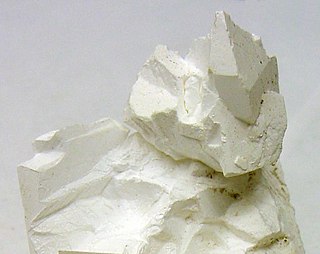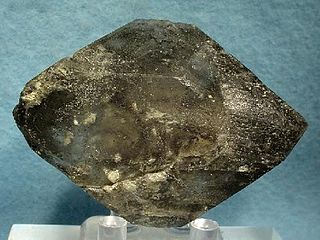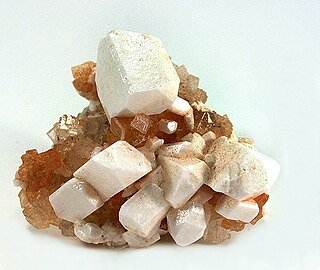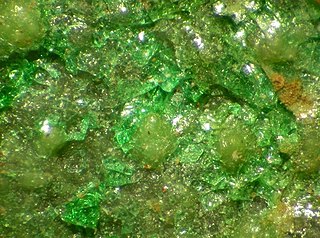Related Research Articles

Sodium carbonate is the inorganic compound with the formula Na2CO3 and its various hydrates. All forms are white, odourless, water-soluble salts that yield alkaline solutions in water. Historically, it was extracted from the ashes of plants grown in sodium-rich soils, and because the ashes of these sodium-rich plants were noticeably different from ashes of wood, sodium carbonate became known as "soda ash". It is produced in large quantities from sodium chloride and limestone by the Solvay process, as well as by carbonating sodium hydroxide which is made using the chloralkali process.

Magnesium sulfate or magnesium sulphate is a chemical compound, a salt with the formula MgSO4, consisting of magnesium cations Mg2+ (20.19% by mass) and sulfate anions SO2−4. It is a white crystalline solid, soluble in water but not in ethanol.

Brucite is the mineral form of magnesium hydroxide, with the chemical formula Mg(OH)2. It is a common alteration product of periclase in marble; a low-temperature hydrothermal vein mineral in metamorphosed limestones and chlorite schists; and formed during serpentinization of dunites. Brucite is often found in association with serpentine, calcite, aragonite, dolomite, magnesite, hydromagnesite, artinite, talc and chrysotile.

Magnesium carbonate, MgCO3, is an inorganic salt that is a colourless or white solid. Several hydrated and basic forms of magnesium carbonate also exist as minerals.

Copper(II) sulfate is an inorganic compound with the chemical formula CuSO4. It forms hydrates CuSO4·nH2O, where n can range from 1 to 7. The pentahydrate (n = 5), a bright blue crystal, is the most commonly encountered hydrate of copper(II) sulfate, while its anhydrous form is white. Older names for the pentahydrate include blue vitriol, bluestone, vitriol of copper, and Roman vitriol. It exothermically dissolves in water to give the aquo complex [Cu(H2O)6]2+, which has octahedral molecular geometry. The structure of the solid pentahydrate reveals a polymeric structure wherein copper is again octahedral but bound to four water ligands. The Cu(II)(H2O)4 centers are interconnected by sulfate anions to form chains.

Magnesium chloride is an inorganic compound with the formula MgCl2. It forms hydrates MgCl2·nH2O, where n can range from 1 to 12. These salts are colorless or white solids that are highly soluble in water. These compounds and their solutions, both of which occur in nature, have a variety of practical uses. Anhydrous magnesium chloride is the principal precursor to magnesium metal, which is produced on a large scale. Hydrated magnesium chloride is the form most readily available.

Chalcanthite (from Ancient Greek χάλκανθον (khálkanthon), from χαλκός (khalkós) 'copper' and ἄνθος (ánthos) 'flower, bloom') is a richly colored blue-green water-soluble sulfate mineral CuSO4·5H2O. It is commonly found in the late-stage oxidation zones of copper deposits. Due to its ready solubility, chalcanthite is more common in arid regions.

Sodium sulfate (also known as sodium sulphate or sulfate of soda) is the inorganic compound with formula Na2SO4 as well as several related hydrates. All forms are white solids that are highly soluble in water. With an annual production of 6 million tonnes, the decahydrate is a major commodity chemical product. It is mainly used as a filler in the manufacture of powdered home laundry detergents and in the Kraft process of paper pulping for making highly alkaline sulfides.

Potassium sulfate (US) or potassium sulphate (UK), also called sulphate of potash (SOP), arcanite, or archaically potash of sulfur, is the inorganic compound with formula K2SO4, a white water-soluble solid. It is commonly used in fertilizers, providing both potassium and sulfur.
In chemistry, water(s) of crystallization or water(s) of hydration are water molecules that are present inside crystals. Water is often incorporated in the formation of crystals from aqueous solutions. In some contexts, water of crystallization is the total mass of water in a substance at a given temperature and is mostly present in a definite (stoichiometric) ratio. Classically, "water of crystallization" refers to water that is found in the crystalline framework of a metal complex or a salt, which is not directly bonded to the metal cation.

Blödite or bloedite is a hydrated sodium magnesium sulfate mineral with the formula Na2Mg(SO4)2·4H2O. The mineral is clear to yellow in color often darkened by inclusions and forms monoclinic crystals.

Murashige and Skoog medium is the most popular plant growth medium used in the laboratories worldwide for cultivation of plant cell culture on agar.

Meridianiite is the mineral consisting of magnesium sulfate undecahydrate, MgSO
4·11H
2O. It is colorless transparent crystalline salt that precipitates from solutions saturated in Mg2+ and SO42− ions at temperatures less than 2 °C. The synthetic compound was formerly known as Fritzsche's salt.
This list gives an overview of the classification of non-silicate minerals and includes mostly International Mineralogical Association (IMA) recognized minerals and its groupings. This list complements the List of minerals recognized by the International Mineralogical Association series of articles and List of minerals. Rocks, ores, mineral mixtures, not IMA approved minerals, not named minerals are mostly excluded. Mostly major groups only, or groupings used by New Dana Classification and Mindat.

Leonite is a hydrated double sulfate of magnesium and potassium. It has the formula K2SO4·MgSO4·4H2O. The mineral was named after Leo Strippelmann, who was director of the salt works at Westeregeln in Germany. The mineral is part of the blodite group of hydrated double sulfate minerals.

Widgiemoolthalite is a rare hydrated nickel(II) carbonate mineral with the chemical formula (Ni,Mg)5(CO3)4(OH)2·5H2O. Usually bluish-green in color, it is a brittle mineral formed during the weathering of nickel sulfide. Present on gaspéite surfaces, widgiemoolthalite has a Mohs scale hardness of 3.5 and an unknown though likely disordered crystal structure. Widgiemoolthalite was first discovered in 1992 in Widgiemooltha, Western Australia, which is to date its only known source. It was named the following year by the three researchers who first reported its existence, Ernest H. Nickel, Bruce W. Robinson, and William G. Mumme.

The sulfate carbonates are a compound carbonates, or mixed anion compounds that contain sulfate and carbonate ions. Sulfate carbonate minerals are in the 7.DG and 5.BF Nickel-Strunz groupings.
A sulfite sulfate is a chemical compound that contains both sulfite and sulfate anions [SO3]2− [SO4]2−. These compounds were discovered in the 1980s as calcium and rare earth element salts. Minerals in this class were later discovered. Minerals may have sulfite as an essential component, or have it substituted for another anion as in alloriite. The related ions [O3SOSO2]2− and [(O2SO)2SO2]2− may be produced in a reaction between sulfur dioxide and sulfate and exist in the solid form as tetramethyl ammonium salts. They have a significant partial pressure of sulfur dioxide.
The phosphate sulfates are mixed anion compounds containing both phosphate and sulfate ions. Related compounds include the arsenate sulfates, phosphate selenates, and arsenate selenates.
References
- ↑ Archibald, E. H.; Gale, W. A. (August 1924). "The System Magnesium Sulfate-Sodium Sulfate-Water and a Method for the Separation of the Salts". Journal of the American Chemical Society. 46 (8): 1760–1771. Bibcode:1924JAChS..46.1760A. doi:10.1021/ja01673a002.
- ↑ Leduc, Evelyne M. S.; Peterson, Ronald C.; Wang, Ruiyao (24 October 2009). "Sodium magnesium sulfate decahydrate, Na2Mg(SO4)2·10H2O, a new sulfate salt". Acta Crystallographica Section C. 65 (11): i81–i84. Bibcode:2009AcCrC..65I..81L. doi:10.1107/S0108270109028881. PMID 19893219.
- ↑ Leftwich, K.; Bish, D. L.; Chen, C. H. (1 October 2013). "Crystal structure and hydration/dehydration behavior of Na2Mg(SO4)2•16H2O: A new hydrate phase observed under Mars-relevant conditions". American Mineralogist. 98 (10): 1772–1778. Bibcode:2013AmMin..98.1772L. doi:10.2138/am.2013.4509. S2CID 100629191.
- ↑ Rakhmatzhanov, U. D.; Mirzakulov, Kh. Ch. (29 September 2023). "Polythermal Solubility of the MgSO4–Na2SО4–H2O System". Russian Journal of Inorganic Chemistry. 68 (11): 1606–1610. doi:10.1134/S0036023623601642. S2CID 263274944.
- ↑ "Konyaite: Konyaite mineral information and data". www.mindat.org.
- ↑ "Löweite: Löweite mineral information and data". www.mindat.org.
- ↑ Mineralogy Database, Mindat.org
- 1 2 3 4 Trussov, I.A.; Male, L.L.; Sanjuan, M.L.; Orera, A.; Slater, P.R. (April 2019). "Understanding the complex structural features and phase changes in Na2Mg2(SO4)3: A combined single crystal and variable temperature powder diffraction and Raman spectroscopy study". Journal of Solid State Chemistry. 272: 157–165. Bibcode:2019JSSCh.272..157T. doi:10.1016/j.jssc.2019.02.014. hdl: 10261/192264 . S2CID 104364241.
- ↑ Kubel, Frank; Cabaret-Lampin, Marie (August 2013). "Syntheses and Structures of Na2Mg3(OH)2 (SO4)4·4H2O and K2Mg3(OH)3(SO4)4·2H2O". Zeitschrift für anorganische und allgemeine Chemie. 639 (10): 1782–1786. doi:10.1002/zaac.201300174.
- ↑ Schmidt, Gregory R.; Reynard, Jacqueline; Yang, Hexiong; Downs, Robert T. (6 September 2006). "Tychite, Na6Mg2(SO4)(CO3)4 : structure analysis and Raman spectroscopic data". Acta Crystallographica Section E. 62 (10): i207–i209. Bibcode:2006AcCrE..62I.207S. doi:10.1107/S160053680603491X.
- ↑ "Uklonskovite: Uklonskovite mineral information and data". www.mindat.org.